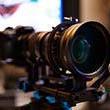-
Posts
388 -
Joined
-
Last visited
Reputation Activity
-
 M Carter got a reaction from nahua in The Effect Of Owning A Very Expensive Camera (for business)
M Carter got a reaction from nahua in The Effect Of Owning A Very Expensive Camera (for business)
There's a whole world of clients out there that don't know the first thing about cameras. On rare occasions, there will be someone involved who's played with DSLRs for video and asks tons of questions. Maybe people shooting national TV spots get into these issues, but for small corporations, startups, entrepreneurs doing web marketing, email blasts, Facebook video campaigns and internal communications/training - they pretty much want to see your reel or examples of stuff that is in line with what I'm proposing or what they envision. If an agency I work with gets the gig, I don't even show a thing - the end client trusts the agency.
That said - if I shoot with a kitted-out DSLR - matte box, follow focus, rails, monitor, loupe, a big geared prime or zoom and an audio recorder - it does look pretty cool on the tripod. Now the total costs of all that may be well under $2k, but I've had clients squeeze through a tight set in terror of bumping the camera and, literally, they've said "I bet that cost more than my house!" It doesn't hurt for a client to perceive that you're using very high-end gear.
But you could be shooting a national TV spot for Revlon and tests showed the BMC pocket with a super-16 lens from the 70's gives the exact look, and the director wouldn't blink an eye - whereas one of my clients would be "hey, you just stuck a lens on a iPhone, right??" For the size of clients I mention above (and in a big city, you can make a good living at that level) setting up an $800 Kessler crane makes them feel like they're getting a lot of bang for their buck. Don't disregard this sort of perception from people without knowledge of the tech side, who are writing the checks.
-
 M Carter got a reaction from IronFilm in The Effect Of Owning A Very Expensive Camera (for business)
M Carter got a reaction from IronFilm in The Effect Of Owning A Very Expensive Camera (for business)
There's a whole world of clients out there that don't know the first thing about cameras. On rare occasions, there will be someone involved who's played with DSLRs for video and asks tons of questions. Maybe people shooting national TV spots get into these issues, but for small corporations, startups, entrepreneurs doing web marketing, email blasts, Facebook video campaigns and internal communications/training - they pretty much want to see your reel or examples of stuff that is in line with what I'm proposing or what they envision. If an agency I work with gets the gig, I don't even show a thing - the end client trusts the agency.
That said - if I shoot with a kitted-out DSLR - matte box, follow focus, rails, monitor, loupe, a big geared prime or zoom and an audio recorder - it does look pretty cool on the tripod. Now the total costs of all that may be well under $2k, but I've had clients squeeze through a tight set in terror of bumping the camera and, literally, they've said "I bet that cost more than my house!" It doesn't hurt for a client to perceive that you're using very high-end gear.
But you could be shooting a national TV spot for Revlon and tests showed the BMC pocket with a super-16 lens from the 70's gives the exact look, and the director wouldn't blink an eye - whereas one of my clients would be "hey, you just stuck a lens on a iPhone, right??" For the size of clients I mention above (and in a big city, you can make a good living at that level) setting up an $800 Kessler crane makes them feel like they're getting a lot of bang for their buck. Don't disregard this sort of perception from people without knowledge of the tech side, who are writing the checks.
-
 M Carter got a reaction from IronFilm in Nikon D7200
M Carter got a reaction from IronFilm in Nikon D7200
You can put all kinds of glass on an NX1 with adapters.
-
 M Carter got a reaction from Marco Tecno in Nikon D7200
M Carter got a reaction from Marco Tecno in Nikon D7200
You can put all kinds of glass on an NX1 with adapters.
-
 M Carter got a reaction from David Eckenrode in My open letter to Panasonic. DVX200 will be lonely, needs a brother called AF200!
M Carter got a reaction from David Eckenrode in My open letter to Panasonic. DVX200 will be lonely, needs a brother called AF200!
I'm presently agonizing over, say, and NX1 or really biting the bullet (artillery shell?) and getting something like the Ursa mini. For my work that I need to look beautiful.
But y'know what? 70% of my video income the last year has been with an AC-130. Not sure why, one big corporate client likes me to shoot their community events and whatnot. I grabbed that camera the week before a shoot out of the US, loved it and still use it weekly.
Sometimes the local news is out there (smaller markets, big master planned communites out in the country - but $1m homes) with their DSLRs and AF-100's. And when things are moving fast, they miss about half the shots when I get 'em all.
All I've wanted as an upgrade for that kind of work is a 4K 24p camera, that can at least do 1080@60p, with decent low light and that will take my existing focus and zoom controls.
Looks like I got it. There's a market for this camera. At $5k, I dunno - under $4k, yeah. Sure, I guess we could use a another swappable-lens "cinema" camera with 4K. Throw in remote focus, iris and zoom, built-in ND, XLRs, etc, a good VF and affordable media and I could see it replacing this form factor for me - I would love love LOVE to have one system for everything I do. But often that means it doesn't do everything well. This new camera is great for a scenario that has a lot of billable hours. It's an evolution of a product that's worked well, from the DVX to the HMC to the AC line. I'm pretty psyched.
-
 M Carter got a reaction from Jaime Valles in My open letter to Panasonic. DVX200 will be lonely, needs a brother called AF200!
M Carter got a reaction from Jaime Valles in My open letter to Panasonic. DVX200 will be lonely, needs a brother called AF200!
Why would you want an ENG camera with interchangeable lenses? The idea is to get out there and shoot, not say "oh, this fire would look better with my wide lens instead of my normal - please don't do anything cool for a couple minutes, firemen..."
I get the very strong feeling that people ragging on this camera have never done a real run/gun shoot of a fast moving & unscripted event, where they have to run between indoors and outdoors, get all the shots from sunrise to dusk, be grabbed for quick interviews in the middle of it all, etc. Like I said earlier, some quarters that's 70-80% of my income. Yeah, I wish I could pay 100% of my mortgage with awesome music videos, but it beats sitting in a cubicle.
The Ursa Mini for ENG/run & gun? Sure, if it has ND, focus, iris and zoom that can be controlled from shoulder mount handle (or crane back), very good stabilization, multiple gain levels via switch, 1-press manual white balance, a great EVF with useable peaking, affordable media, long-lasting battery, and a very wide zoom range, light enough to live on the shoulder all day if needed. That's what (at least) I need for event shooting (hell, I don't even need AF or any auto functions).
Realistically, you're talking two different cameras for two very different uses.
-
 M Carter got a reaction from Jimbo in My open letter to Panasonic. DVX200 will be lonely, needs a brother called AF200!
M Carter got a reaction from Jimbo in My open letter to Panasonic. DVX200 will be lonely, needs a brother called AF200!
I'm presently agonizing over, say, and NX1 or really biting the bullet (artillery shell?) and getting something like the Ursa mini. For my work that I need to look beautiful.
But y'know what? 70% of my video income the last year has been with an AC-130. Not sure why, one big corporate client likes me to shoot their community events and whatnot. I grabbed that camera the week before a shoot out of the US, loved it and still use it weekly.
Sometimes the local news is out there (smaller markets, big master planned communites out in the country - but $1m homes) with their DSLRs and AF-100's. And when things are moving fast, they miss about half the shots when I get 'em all.
All I've wanted as an upgrade for that kind of work is a 4K 24p camera, that can at least do 1080@60p, with decent low light and that will take my existing focus and zoom controls.
Looks like I got it. There's a market for this camera. At $5k, I dunno - under $4k, yeah. Sure, I guess we could use a another swappable-lens "cinema" camera with 4K. Throw in remote focus, iris and zoom, built-in ND, XLRs, etc, a good VF and affordable media and I could see it replacing this form factor for me - I would love love LOVE to have one system for everything I do. But often that means it doesn't do everything well. This new camera is great for a scenario that has a lot of billable hours. It's an evolution of a product that's worked well, from the DVX to the HMC to the AC line. I'm pretty psyched.
-
 M Carter got a reaction from neosushi in Audio on GH4 and NX1
M Carter got a reaction from neosushi in Audio on GH4 and NX1
I can't imagine getting really pristine sound from any DSLR - so-so circuitry designed to be tiny, not awesome.
It's not about camera gain settings or XLR adapters. Don't choose a camera based on its audio capabilities, choose it as a camera. A Tascam DR-60 is 10x the utility and quality, and comes with PluralEyes, so your synch issues are history. 2 tracks with phantom power (and a -6DB backup track of each for safety) and 2 more line ins, headphone out with a level KNOB and line out - with a knob as well. A really, really unobtrusive limiter and a low cut. Can't beat it for $200. And that's just the entry level, but you get XLR combo's, good meters, a wealth of features.
I shoot plenty of corporate stuff all by myself. It really doesn't take me any remarkable amount of time to plug my mics into a recorder vs. a camera. When I'm doing interview stuff or planned-out stuff with DSLR or BMC style cameras, I run a line out from the Tascam to the camera for cleaner synch. But PluralEyes synchs with the in-camera mic just fine. You can mount a recorder on your rails or stick it where it's convenient.
If the gig is just a crazy run & gun deal, I use a "video" camera with ND, zoom, a real viewfinder with peaking, XLRs, etc. I've watched the DSLR guys miss 20% of their shots at those deals.
Plugging mics into an NX1 (or a 5D or a Nikon or a BMC)... just don't do it. If you can afford a YHAGI you can afford a great recorder and do it right. $199 gets you out of the crap preamps realm, and if you have more budget you can get more. And the YHAGI is pretty overpriced unless you need the SDI. Dual system sound just does not add complexity to worry about. YMMV and my .02 of course...
-
 M Carter got a reaction from Ed_David in Yet another depressing story about Kodak!
M Carter got a reaction from Ed_David in Yet another depressing story about Kodak!
Getting involved in a film vs. digital argument is a waste of time. They're both good for specific needs.
A year ago I built a wet darkroom. It's freaking magic in there. Photoshop and AE are pretty magical as well. Film is far from dead - Ilford stuck with it with their fingers crossed - they've been seeing sales growth and predict a healthy (though smaller than the past) market.
A good friend on mine said "it's like Vinyl vs. MP3 - and Vinyls' suddenly cool again..."
-
 M Carter got a reaction from nahua in I need help to understand better the Tescam DR 60d MKII. and Tescam Vs. Zoom H6.
M Carter got a reaction from nahua in I need help to understand better the Tescam DR 60d MKII. and Tescam Vs. Zoom H6.
Can't speak for the zoom. The DR60D can be odd with AA rechargeable batteries - I think if you have one that's starting to get weak, the 60D detects it and starts throwing warnings. Seems picky about rechargeables. But with a USB battery (the kind to make your phone run longer, by Anker, etc, $20-$30 - it'll run about 24 hours. So that's all I use now).
The 60D has phantom power and will "handle" any professional mic signal. I feel the meters are too conservative - you would want to do some tests, record some test audio and look at the waveforms in an editor - it doesn't have tons of gain to spare but is fine for anyone that knows gain staging and mic placement. I find the limiter and low-cut to be very well done and I just leave 'em on now. I shot an Emmylou Harris solo show and used it for the board feed, I turned off the limiter and low-cut for that. Final mix really came out nice.
-
 M Carter got a reaction from nahua in I need help to understand better the Tescam DR 60d MKII. and Tescam Vs. Zoom H6.
M Carter got a reaction from nahua in I need help to understand better the Tescam DR 60d MKII. and Tescam Vs. Zoom H6.
Works fine for me and is very useful.
I have the original, not the MKII - you really need to do some tests with the unit - my meters are very conservative, and if I set levels at what seems proper, I have pretty weak tracks. The self-noise of the 60D is fine, but I'd really like a beefy waveform. Set it to really hit the peaks and use the minus-6 backups.
The limiter is very natural sounding - I use it all the time. It's not a total brickwall, but it helps.
One of those Anker USB phone batteries will power the DR-60 for hours or days. The the 60D is very picky about internal batteries and will report "dead battery" for batteries with a lot of juice left, esp. with rechargeables. Any USB power source (like a little phone charging brick) will power it via USB if necessary when you're in the studio.
One final tip - just do the quick format for cards - the full format, myself and many people give up after ten minutes or so and disconnect power.
-
 M Carter got a reaction from itimjim in The art of downgrading
M Carter got a reaction from itimjim in The art of downgrading
This thread doesn't address one of the greatest issues of choice vs. creativity - which is partnership vs. control.
For the last year or so, I work work work with macs and digital... but my creative work, my play? Film, 60's era metal cameras, an enlarger and lith developer.
Every step of that process means working within the confines of the medium. Particularly lith printing, which is very hard to replicate across 2 prints, and is packed with "ghost-in-the-machine" oddities based on chemistry and temperature and the fact that every print you make changes the chemical composition of the developer. You simply can't "control" any step of the process with any sort of totality, from exposure to final print, like you can with a digital camera and Photoshop.
But once you decide you are a "partner" with the media, the game changes. Why do we make partnerships? Usually to add unique strengths which we don't possess or aren't remarkable at, to our creative, business, romantic, or fun pursuits. When you allow chance and surprise into the process, its like being handed a very active and very able muse.
I shot about 200 frames, digital, of a nude for a friend who wanted to get a sense of "how she looked" in that scenario. I shot 3 or 4 frames with an old Minolta rangefinder, and one of those just had lots of the mojo I want from a shot. Printing it was work - to get those tools to sculpt the print into what I wanted, while making room for the oddities of the process and making them work together. It's probably my favorite bit of creative output this year. And those things inform my "controlled" work as well.
-
 M Carter got a reaction from JazzBox in I need help to understand better the Tescam DR 60d MKII. and Tescam Vs. Zoom H6.
M Carter got a reaction from JazzBox in I need help to understand better the Tescam DR 60d MKII. and Tescam Vs. Zoom H6.
Can't speak for the zoom. The DR60D can be odd with AA rechargeable batteries - I think if you have one that's starting to get weak, the 60D detects it and starts throwing warnings. Seems picky about rechargeables. But with a USB battery (the kind to make your phone run longer, by Anker, etc, $20-$30 - it'll run about 24 hours. So that's all I use now).
The 60D has phantom power and will "handle" any professional mic signal. I feel the meters are too conservative - you would want to do some tests, record some test audio and look at the waveforms in an editor - it doesn't have tons of gain to spare but is fine for anyone that knows gain staging and mic placement. I find the limiter and low-cut to be very well done and I just leave 'em on now. I shot an Emmylou Harris solo show and used it for the board feed, I turned off the limiter and low-cut for that. Final mix really came out nice.
-
 M Carter got a reaction from agolex in The art of downgrading
M Carter got a reaction from agolex in The art of downgrading
This thread doesn't address one of the greatest issues of choice vs. creativity - which is partnership vs. control.
For the last year or so, I work work work with macs and digital... but my creative work, my play? Film, 60's era metal cameras, an enlarger and lith developer.
Every step of that process means working within the confines of the medium. Particularly lith printing, which is very hard to replicate across 2 prints, and is packed with "ghost-in-the-machine" oddities based on chemistry and temperature and the fact that every print you make changes the chemical composition of the developer. You simply can't "control" any step of the process with any sort of totality, from exposure to final print, like you can with a digital camera and Photoshop.
But once you decide you are a "partner" with the media, the game changes. Why do we make partnerships? Usually to add unique strengths which we don't possess or aren't remarkable at, to our creative, business, romantic, or fun pursuits. When you allow chance and surprise into the process, its like being handed a very active and very able muse.
I shot about 200 frames, digital, of a nude for a friend who wanted to get a sense of "how she looked" in that scenario. I shot 3 or 4 frames with an old Minolta rangefinder, and one of those just had lots of the mojo I want from a shot. Printing it was work - to get those tools to sculpt the print into what I wanted, while making room for the oddities of the process and making them work together. It's probably my favorite bit of creative output this year. And those things inform my "controlled" work as well.
-
 M Carter got a reaction from Wulf in The art of downgrading
M Carter got a reaction from Wulf in The art of downgrading
This thread doesn't address one of the greatest issues of choice vs. creativity - which is partnership vs. control.
For the last year or so, I work work work with macs and digital... but my creative work, my play? Film, 60's era metal cameras, an enlarger and lith developer.
Every step of that process means working within the confines of the medium. Particularly lith printing, which is very hard to replicate across 2 prints, and is packed with "ghost-in-the-machine" oddities based on chemistry and temperature and the fact that every print you make changes the chemical composition of the developer. You simply can't "control" any step of the process with any sort of totality, from exposure to final print, like you can with a digital camera and Photoshop.
But once you decide you are a "partner" with the media, the game changes. Why do we make partnerships? Usually to add unique strengths which we don't possess or aren't remarkable at, to our creative, business, romantic, or fun pursuits. When you allow chance and surprise into the process, its like being handed a very active and very able muse.
I shot about 200 frames, digital, of a nude for a friend who wanted to get a sense of "how she looked" in that scenario. I shot 3 or 4 frames with an old Minolta rangefinder, and one of those just had lots of the mojo I want from a shot. Printing it was work - to get those tools to sculpt the print into what I wanted, while making room for the oddities of the process and making them work together. It's probably my favorite bit of creative output this year. And those things inform my "controlled" work as well.
-
 M Carter got a reaction from IronFilm in I need help to understand better the Tescam DR 60d MKII. and Tescam Vs. Zoom H6.
M Carter got a reaction from IronFilm in I need help to understand better the Tescam DR 60d MKII. and Tescam Vs. Zoom H6.
Works fine for me and is very useful.
I have the original, not the MKII - you really need to do some tests with the unit - my meters are very conservative, and if I set levels at what seems proper, I have pretty weak tracks. The self-noise of the 60D is fine, but I'd really like a beefy waveform. Set it to really hit the peaks and use the minus-6 backups.
The limiter is very natural sounding - I use it all the time. It's not a total brickwall, but it helps.
One of those Anker USB phone batteries will power the DR-60 for hours or days. The the 60D is very picky about internal batteries and will report "dead battery" for batteries with a lot of juice left, esp. with rechargeables. Any USB power source (like a little phone charging brick) will power it via USB if necessary when you're in the studio.
One final tip - just do the quick format for cards - the full format, myself and many people give up after ten minutes or so and disconnect power.
-
 M Carter got a reaction from Nick Hughes in I need help to understand better the Tescam DR 60d MKII. and Tescam Vs. Zoom H6.
M Carter got a reaction from Nick Hughes in I need help to understand better the Tescam DR 60d MKII. and Tescam Vs. Zoom H6.
Works fine for me and is very useful.
I have the original, not the MKII - you really need to do some tests with the unit - my meters are very conservative, and if I set levels at what seems proper, I have pretty weak tracks. The self-noise of the 60D is fine, but I'd really like a beefy waveform. Set it to really hit the peaks and use the minus-6 backups.
The limiter is very natural sounding - I use it all the time. It's not a total brickwall, but it helps.
One of those Anker USB phone batteries will power the DR-60 for hours or days. The the 60D is very picky about internal batteries and will report "dead battery" for batteries with a lot of juice left, esp. with rechargeables. Any USB power source (like a little phone charging brick) will power it via USB if necessary when you're in the studio.
One final tip - just do the quick format for cards - the full format, myself and many people give up after ten minutes or so and disconnect power.
-
 M Carter got a reaction from 1tkman in Audio on GH4 and NX1
M Carter got a reaction from 1tkman in Audio on GH4 and NX1
I've wondered myself - if the screw mount on the 70d is the same hardware as the 60d, that thing is pretty big!
My only issue with the 60D? When the meter says it's peaking, it's not even close. I've gotten a lot of audio tracks that are pretty weak until I learned to (A) kinda slam the meters, (B) activate the -6DB safety track for peace of mind and (C) use the limiter (See"B")!
Also, it has some issues with rechargeable batteries, announcing they're too low of a charge. But the 60D will run ALL FREAKING DAY with something like an Anker USB battery - $30!!
I mount mine on a crossbar of 15mm rod, works great for tripod work...
-
 M Carter got a reaction from Flynn in Audio on GH4 and NX1
M Carter got a reaction from Flynn in Audio on GH4 and NX1
I can't imagine getting really pristine sound from any DSLR - so-so circuitry designed to be tiny, not awesome.
It's not about camera gain settings or XLR adapters. Don't choose a camera based on its audio capabilities, choose it as a camera. A Tascam DR-60 is 10x the utility and quality, and comes with PluralEyes, so your synch issues are history. 2 tracks with phantom power (and a -6DB backup track of each for safety) and 2 more line ins, headphone out with a level KNOB and line out - with a knob as well. A really, really unobtrusive limiter and a low cut. Can't beat it for $200. And that's just the entry level, but you get XLR combo's, good meters, a wealth of features.
I shoot plenty of corporate stuff all by myself. It really doesn't take me any remarkable amount of time to plug my mics into a recorder vs. a camera. When I'm doing interview stuff or planned-out stuff with DSLR or BMC style cameras, I run a line out from the Tascam to the camera for cleaner synch. But PluralEyes synchs with the in-camera mic just fine. You can mount a recorder on your rails or stick it where it's convenient.
If the gig is just a crazy run & gun deal, I use a "video" camera with ND, zoom, a real viewfinder with peaking, XLRs, etc. I've watched the DSLR guys miss 20% of their shots at those deals.
Plugging mics into an NX1 (or a 5D or a Nikon or a BMC)... just don't do it. If you can afford a YHAGI you can afford a great recorder and do it right. $199 gets you out of the crap preamps realm, and if you have more budget you can get more. And the YHAGI is pretty overpriced unless you need the SDI. Dual system sound just does not add complexity to worry about. YMMV and my .02 of course...
-
 M Carter got a reaction from nikonstills in Light stands
M Carter got a reaction from nikonstills in Light stands
This grew out of a discussion over on DVX user, thought I'd add it here if anyone is interested.
A poster asked "what is the best c-stand" and my reply was "usually, not a c-stand".
C stands are designed to get small lights and flags into a maze of light stand feet. They're not intended for overheads or big 2K fresnels. They tip easily, they're hard to pack, and the way the column meets the base at a single point makes them even more prone to tipping. For some reason, "c-stand" has become a sort of knee-jerk must-have for people starting to build a kit. I like having c-stands, but especially on a tight budget, I'd shop for stands that are more versatile, can hold more weight with greater stability, are easier to pack, and could reasonably be used for, say, an 8x8 overhead in calm conditions, and (hopefully) cost the same or less. Something that can take an XL softbox or a big octagon without 3 sandbags and prayer.
I'm comparing stands here to the Avenger Turtle-Base (unless you are 100% studio, you really don't want 1-piece C-stands - I feel they're a pain to pack). And turtles do give you the floor-stand option with a butt plug. Yet I'd take a Beefy Baby over a c-stand any day, in most cases.
So - Stands in the $200 or less range you should consider. In the US, all the stands below can be found with free US shipping. There's probably a few more choices out there, but here's what's top of my radar:
BEST VALUE:
Matthews Steel Kit Stand
25 lb load, 37" footprint - 9.5 ft. tall
(Actually better height, load and footprint than the Beefy Baby)
$87, free shipping
Not as heavy steel as Beefy Babies (and thus lighter to pack)... and, DUDE, eighty seven bucks!! That's two c-stands!!
THE KING OF AFFORDABLE STANDS:
Kupo Master Combo HD $156
88 freaking pounds max. load!
55" footprint! ELEVEN FEET high.
baby pin AND junior receiver.
Leveling leg!
Cons: a very very wide footprint (very stable) that might be overkill on a tiny set.
OR SAVE A FEW BUCKS:
Kupo Master Combo Alu Senior Stand $144
26.5 lb load at a maximum height of 12' 4".
Footprint: 46" - still pretty big.
Aluminum construction, a triple function universal head and a leveling leg.
THE KNEE JERK C-STAND, (most agree) THE BEST VERSION AVAILABLE:
Avenger turtle base c-stand $169
9.8' feet height, 3' footprint, 22 lb max load, baby pin. Anyone who puts 22 lbs. on a fully extendedd c-stand may be asking for trouble though...
If you shoot strictly in the studio, you can save some money and get 1-piece (non turtle) c-stands. Which are a pain to pack.
If you use turtle base stands, you should invest in some butt plugs at $20 or so each. Makes a great floor-level stand.
Or buy the narrower turtle base and a butt plug.
BEST ALTERNATES TO THE C-STAND
In addition to that $87 Steel Kit Stand...
Matthews Beefy Beefy Double Riser $173
8.5' height, 22 lb max load 33" footprint. An industry standard. Essentially same price as the best c-stand.
(Was manufactured with a 12' aluminum column for some time, and those show up cheap on the used market - I wouldn't extend those fully or use in the wind, as the column is weaker than steel. I have two of the aluminum stands and I feel the column could buckle with enough stress. Great lightweight stand to get smaller flags up very high though, great for big softboxes at reasonable heights.)
Matthews Beefy Beefy Triple Riser $203
12 ft height, 20 lbs max load 33" footprint. A killer stand.
WANT WHEELS ON A KILLER STAND?
Kupo Junior Roller $199
17 lb max load - 45" footprint - 8.8' high
With super useful and good-sized braking wheels - bigger wheels than the Matthews roller in fact, which don't have brakes (well, mine don't).
(Avenger roller is same price, 1 foot shorter, only 28" footprint.) The giant footprint of the Kupo roller suggests it could be used for smaller overheads in calm conditions if big height isn't needed.
This type of stand is a dynamite thing to have - I use them for microphone booms, they're sturdy and reposition fast, rarely need sand bags.
-
 M Carter got a reaction from nvldk in Kodak celluloid film saved by studios - oh and by the way - what's the point?
M Carter got a reaction from nvldk in Kodak celluloid film saved by studios - oh and by the way - what's the point?
The added "what's the point" by the OP seems a bit troll-ish to me...
I bought a killer super-8 camera for music videos - I've yet to find someone who wants to pay the added costs though. But man, pushing tungsten reversal film about three stops - magic, gorgeous.
But as a still shooter - I only do digital for work and have restored my wet darkroom. There are things film and paper can do that photoshop simply can't even approach. And every time I get a beautiful process dialed in, seems like one of the elements needed for it gets discontinued and I want to go have a good cry. So you go, Kodak.
-
 M Carter got a reaction from andrgl in Light stands
M Carter got a reaction from andrgl in Light stands
Film really separated the men from the boys. I did a two year portfolio project, 35mm 320T tungsten film pushed 3 stops, then duped (in my enlarger with a flash unit taped to the condenser) to 8x10 velvia or EPP (the shot above is the same technique). Multiple exposures on glass sheets with a different focus point for each layer, and different lights for each exposure. Three to five exposures per frame. No comps of course, Photoshop still shipped on floppy discs back then (I learned Photoshop from version 2.0 - came on like seven floppies and the manual was like a phone book!) - one shot (with brackets). I went through a lot of tungsten Polaroid pack film (which only came in 64T but I was shooting 320T at 3000 asa). Polaroids shot with a Nikon and Forscher fiber-optic back and layers of ND. Bracket like hell and cross your fingers. Came out gorgeous.
The worst part about film shooting? Trying to sleep after a $20k shoot with the film at the lab, no snip tests til morning. You try to sleep with that hanging over your head!
What happens when you push 320T 3 stops (don't worry, it's no longer manufactured):
-
 M Carter got a reaction from Xavier Plagaro Mussard in Light stands
M Carter got a reaction from Xavier Plagaro Mussard in Light stands
This grew out of a discussion over on DVX user, thought I'd add it here if anyone is interested.
A poster asked "what is the best c-stand" and my reply was "usually, not a c-stand".
C stands are designed to get small lights and flags into a maze of light stand feet. They're not intended for overheads or big 2K fresnels. They tip easily, they're hard to pack, and the way the column meets the base at a single point makes them even more prone to tipping. For some reason, "c-stand" has become a sort of knee-jerk must-have for people starting to build a kit. I like having c-stands, but especially on a tight budget, I'd shop for stands that are more versatile, can hold more weight with greater stability, are easier to pack, and could reasonably be used for, say, an 8x8 overhead in calm conditions, and (hopefully) cost the same or less. Something that can take an XL softbox or a big octagon without 3 sandbags and prayer.
I'm comparing stands here to the Avenger Turtle-Base (unless you are 100% studio, you really don't want 1-piece C-stands - I feel they're a pain to pack). And turtles do give you the floor-stand option with a butt plug. Yet I'd take a Beefy Baby over a c-stand any day, in most cases.
So - Stands in the $200 or less range you should consider. In the US, all the stands below can be found with free US shipping. There's probably a few more choices out there, but here's what's top of my radar:
BEST VALUE:
Matthews Steel Kit Stand
25 lb load, 37" footprint - 9.5 ft. tall
(Actually better height, load and footprint than the Beefy Baby)
$87, free shipping
Not as heavy steel as Beefy Babies (and thus lighter to pack)... and, DUDE, eighty seven bucks!! That's two c-stands!!
THE KING OF AFFORDABLE STANDS:
Kupo Master Combo HD $156
88 freaking pounds max. load!
55" footprint! ELEVEN FEET high.
baby pin AND junior receiver.
Leveling leg!
Cons: a very very wide footprint (very stable) that might be overkill on a tiny set.
OR SAVE A FEW BUCKS:
Kupo Master Combo Alu Senior Stand $144
26.5 lb load at a maximum height of 12' 4".
Footprint: 46" - still pretty big.
Aluminum construction, a triple function universal head and a leveling leg.
THE KNEE JERK C-STAND, (most agree) THE BEST VERSION AVAILABLE:
Avenger turtle base c-stand $169
9.8' feet height, 3' footprint, 22 lb max load, baby pin. Anyone who puts 22 lbs. on a fully extendedd c-stand may be asking for trouble though...
If you shoot strictly in the studio, you can save some money and get 1-piece (non turtle) c-stands. Which are a pain to pack.
If you use turtle base stands, you should invest in some butt plugs at $20 or so each. Makes a great floor-level stand.
Or buy the narrower turtle base and a butt plug.
BEST ALTERNATES TO THE C-STAND
In addition to that $87 Steel Kit Stand...
Matthews Beefy Beefy Double Riser $173
8.5' height, 22 lb max load 33" footprint. An industry standard. Essentially same price as the best c-stand.
(Was manufactured with a 12' aluminum column for some time, and those show up cheap on the used market - I wouldn't extend those fully or use in the wind, as the column is weaker than steel. I have two of the aluminum stands and I feel the column could buckle with enough stress. Great lightweight stand to get smaller flags up very high though, great for big softboxes at reasonable heights.)
Matthews Beefy Beefy Triple Riser $203
12 ft height, 20 lbs max load 33" footprint. A killer stand.
WANT WHEELS ON A KILLER STAND?
Kupo Junior Roller $199
17 lb max load - 45" footprint - 8.8' high
With super useful and good-sized braking wheels - bigger wheels than the Matthews roller in fact, which don't have brakes (well, mine don't).
(Avenger roller is same price, 1 foot shorter, only 28" footprint.) The giant footprint of the Kupo roller suggests it could be used for smaller overheads in calm conditions if big height isn't needed.
This type of stand is a dynamite thing to have - I use them for microphone booms, they're sturdy and reposition fast, rarely need sand bags.
-
 M Carter got a reaction from andrgl in Light stands
M Carter got a reaction from andrgl in Light stands
Good points - though this was really "inspired" by newbies who seem to think c-stands are the only pro stand out there.
And every stand I listed has a baby pin and will take a standard grip head & arm; the juniors have pop-up baby pins with Jr. receivers, and would have you prepared for that first 1.2k HMI you buy from eBay.
@Ieeys, I'm in the US and used US links and only posted items with free US shipping, but many of these should be available on your side of the pond. I have plenty of $50 black steel light stands, many that came with flo's, etc, and they're handy and lightweight. Once you try to boom even a small card with 'em, not so great. Again, I'm suggesting people new to all of this become aware that their heavy-stand dollars can be better spent than just c-stands. For the same investment (or a few bucks more, or even a good deal less) you can get a lot more stand with more versatility.
There are times on a complex shoot (especially product shots) where only a c-stand will fit in that maze of tripod-leg stands - that seems to really be their intended use. Those of us with a product background have been there - the jewelry tabletop with a forest of chrome all around it, a stylist and client trying to get their heads in with a camera on an arm and a giant softbox overhead... I've even loved those little "mini" c's at those times - with the 18" footprint!
This shot took every light stand I owned (film days, shot on EPP) - and I ended up grabbing two microphone stands (products on individual sheets of glass, etc)
-
 M Carter got a reaction from Chrad in Light stands
M Carter got a reaction from Chrad in Light stands
This grew out of a discussion over on DVX user, thought I'd add it here if anyone is interested.
A poster asked "what is the best c-stand" and my reply was "usually, not a c-stand".
C stands are designed to get small lights and flags into a maze of light stand feet. They're not intended for overheads or big 2K fresnels. They tip easily, they're hard to pack, and the way the column meets the base at a single point makes them even more prone to tipping. For some reason, "c-stand" has become a sort of knee-jerk must-have for people starting to build a kit. I like having c-stands, but especially on a tight budget, I'd shop for stands that are more versatile, can hold more weight with greater stability, are easier to pack, and could reasonably be used for, say, an 8x8 overhead in calm conditions, and (hopefully) cost the same or less. Something that can take an XL softbox or a big octagon without 3 sandbags and prayer.
I'm comparing stands here to the Avenger Turtle-Base (unless you are 100% studio, you really don't want 1-piece C-stands - I feel they're a pain to pack). And turtles do give you the floor-stand option with a butt plug. Yet I'd take a Beefy Baby over a c-stand any day, in most cases.
So - Stands in the $200 or less range you should consider. In the US, all the stands below can be found with free US shipping. There's probably a few more choices out there, but here's what's top of my radar:
BEST VALUE:
Matthews Steel Kit Stand
25 lb load, 37" footprint - 9.5 ft. tall
(Actually better height, load and footprint than the Beefy Baby)
$87, free shipping
Not as heavy steel as Beefy Babies (and thus lighter to pack)... and, DUDE, eighty seven bucks!! That's two c-stands!!
THE KING OF AFFORDABLE STANDS:
Kupo Master Combo HD $156
88 freaking pounds max. load!
55" footprint! ELEVEN FEET high.
baby pin AND junior receiver.
Leveling leg!
Cons: a very very wide footprint (very stable) that might be overkill on a tiny set.
OR SAVE A FEW BUCKS:
Kupo Master Combo Alu Senior Stand $144
26.5 lb load at a maximum height of 12' 4".
Footprint: 46" - still pretty big.
Aluminum construction, a triple function universal head and a leveling leg.
THE KNEE JERK C-STAND, (most agree) THE BEST VERSION AVAILABLE:
Avenger turtle base c-stand $169
9.8' feet height, 3' footprint, 22 lb max load, baby pin. Anyone who puts 22 lbs. on a fully extendedd c-stand may be asking for trouble though...
If you shoot strictly in the studio, you can save some money and get 1-piece (non turtle) c-stands. Which are a pain to pack.
If you use turtle base stands, you should invest in some butt plugs at $20 or so each. Makes a great floor-level stand.
Or buy the narrower turtle base and a butt plug.
BEST ALTERNATES TO THE C-STAND
In addition to that $87 Steel Kit Stand...
Matthews Beefy Beefy Double Riser $173
8.5' height, 22 lb max load 33" footprint. An industry standard. Essentially same price as the best c-stand.
(Was manufactured with a 12' aluminum column for some time, and those show up cheap on the used market - I wouldn't extend those fully or use in the wind, as the column is weaker than steel. I have two of the aluminum stands and I feel the column could buckle with enough stress. Great lightweight stand to get smaller flags up very high though, great for big softboxes at reasonable heights.)
Matthews Beefy Beefy Triple Riser $203
12 ft height, 20 lbs max load 33" footprint. A killer stand.
WANT WHEELS ON A KILLER STAND?
Kupo Junior Roller $199
17 lb max load - 45" footprint - 8.8' high
With super useful and good-sized braking wheels - bigger wheels than the Matthews roller in fact, which don't have brakes (well, mine don't).
(Avenger roller is same price, 1 foot shorter, only 28" footprint.) The giant footprint of the Kupo roller suggests it could be used for smaller overheads in calm conditions if big height isn't needed.
This type of stand is a dynamite thing to have - I use them for microphone booms, they're sturdy and reposition fast, rarely need sand bags.













